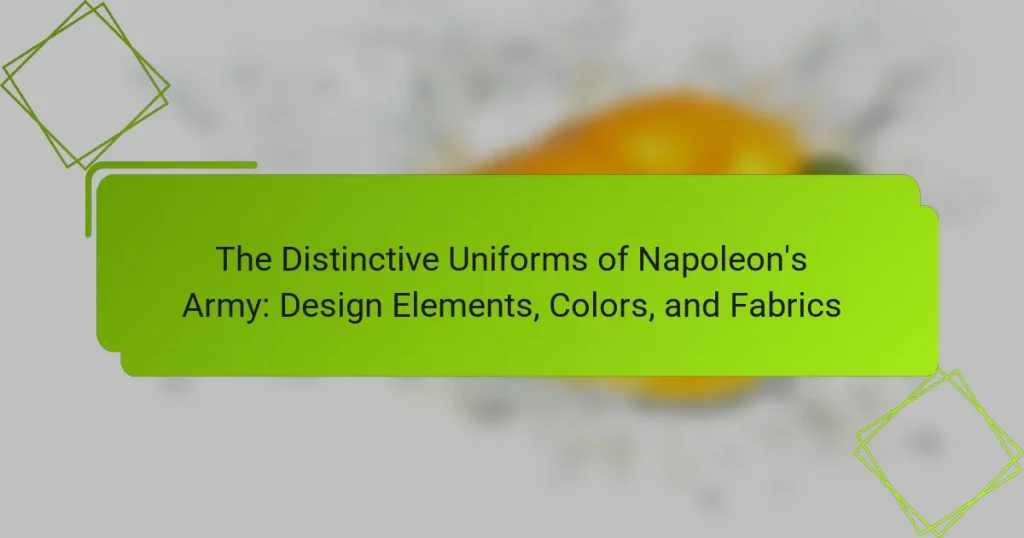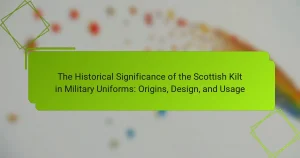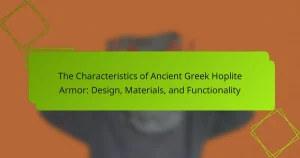The article focuses on the distinctive uniforms of Napoleon’s Army, highlighting their design elements, colors, and fabrics. Key features include the dark blue coats with red facings worn by infantry, which symbolized loyalty and bravery, and the various styles adopted by cavalry units. The historical context, including the influence of the French Revolution and military reforms, shaped these uniforms to reflect national pride and military hierarchy. Additionally, the article discusses the lasting impact of Napoleon’s uniform designs on military fashion, including the introduction of structured designs, bold colors, and elements such as epaulettes and the iconic bicorne hat.
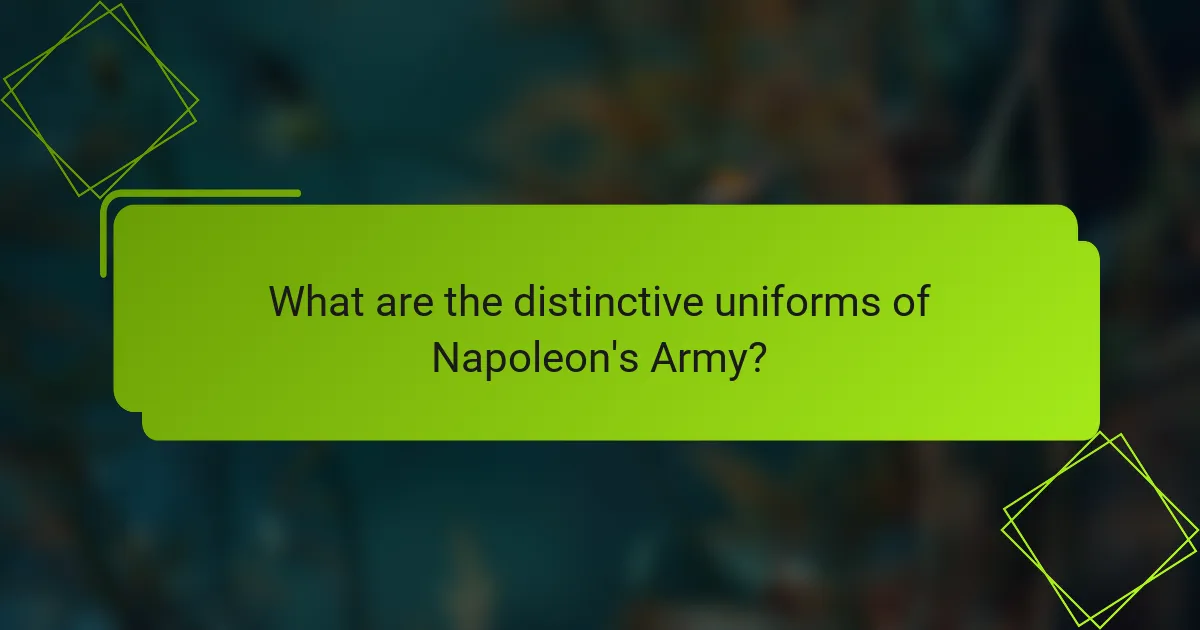
What are the distinctive uniforms of Napoleon’s Army?
The distinctive uniforms of Napoleon’s Army featured specific design elements and colors. The infantry typically wore a dark blue coat with red facings. This color scheme symbolized loyalty and bravery. The trousers were often white or sky blue, depending on the unit. Cavalry units wore different styles, including short jackets and plumed hats. The elite Imperial Guard donned unique uniforms with gold embroidery. These uniforms were made from wool and featured distinct buttons and insignia. The overall design reflected both military hierarchy and national pride. Napoleon’s uniforms became iconic, influencing military fashion in subsequent eras.
How did the design elements of these uniforms reflect military strategy?
The design elements of Napoleon’s army uniforms were strategically crafted for visibility and functionality. Bright colors, such as the iconic blue and red, enhanced troop visibility on the battlefield. This visibility facilitated easier command and control during chaotic engagements. The use of specific insignias and regimental colors allowed for quick identification of units. Tailored cuts provided mobility and comfort, essential for maneuvering in combat. Additionally, the inclusion of epaulettes and sashes signified rank, which was crucial for maintaining order. Historical accounts indicate that these design choices were deliberate, reflecting the need for both aesthetic appeal and tactical advantage in warfare.
What specific design features were commonly used in Napoleon’s uniforms?
Napoleon’s uniforms commonly featured distinct design elements such as high collars, elaborate embroidery, and a tailored fit. The high collar was intended to convey authority and military stature. Embroidery often included intricate gold or silver thread patterns, symbolizing rank and prestige. The tailored fit allowed for ease of movement during battle. Additionally, the use of bright colors, particularly blue, white, and red, was prevalent, representing the French flag. Epaulettes were also a notable feature, denoting rank within the army. These design choices reinforced the image of discipline and unity in Napoleon’s forces.
How did design elements vary across different ranks in the army?
Design elements in Napoleon’s army varied significantly across different ranks. Higher-ranking officers wore more elaborate uniforms with intricate embroidery and distinctive insignia. For example, generals often had gold epaulettes and sashes, signifying their status. In contrast, lower ranks, such as privates, wore simpler designs with minimal embellishments. Their uniforms typically featured basic colors and less ornamentation.
The color palette also differed by rank. Officers had access to richer and more varied colors, while enlisted men wore standardized shades, primarily blue or gray. Fabrics used for higher ranks were of superior quality, often made from fine wool or silk, whereas lower ranks wore coarser materials.
These design variations served both functional and symbolic purposes. They helped distinguish ranks quickly on the battlefield and fostered a sense of hierarchy within the army. Historical records indicate that these distinctions were crucial for maintaining order and discipline.
What role did colors play in the uniforms of Napoleon’s Army?
Colors in the uniforms of Napoleon’s Army served multiple key roles. They indicated rank and unit affiliation. Each color represented different branches of the military. For instance, blue was commonly used for infantry. Red was typical for artillery, while green signified light infantry. These color codes helped in quick identification on the battlefield. Additionally, colors contributed to morale and a sense of unity among troops. Bright colors also made the soldiers visually striking. This was intended to intimidate the enemy and boost the confidence of Napoleon’s forces.
Which colors were predominantly used in these uniforms and why?
The predominantly used colors in Napoleon’s army uniforms were blue, white, and red. Blue was chosen for its association with loyalty and valor. White symbolized purity and was common in military attire. Red was used for accents, representing courage and strength. These colors also aligned with the French national flag, reinforcing national pride. The choice of blue as the main color helped distinguish the French army from other nations. Historical records show these colors became iconic during the Napoleonic Wars, contributing to the army’s identity.
How did color choices influence the perception of the army?
Color choices significantly influenced the perception of Napoleon’s army. The use of bright colors, such as blue and red, created a striking visual identity. These colors were intended to instill pride and unity among soldiers. Bright uniforms made the army more recognizable on the battlefield. They also served to intimidate opponents through a show of strength and cohesion. Historical accounts indicate that the vibrant colors contributed to the army’s morale. The distinctiveness of the uniforms helped in rallying troops and enhancing their fighting spirit. Overall, color choices were a strategic element in shaping the army’s image and effectiveness.
What fabrics were utilized in the making of these uniforms?
The uniforms of Napoleon’s Army were primarily made from wool, cotton, and linen. Wool was favored for its durability and warmth, especially in colder climates. Cotton was often used for lighter uniforms, providing breathability in warmer conditions. Linen was utilized for summer uniforms due to its lightweight nature. These fabrics were essential for ensuring comfort and functionality during military campaigns. Historical records indicate that these materials were commonly used in early 19th-century military attire.
What types of fabrics were preferred for different uniform components?
Napoleon’s army preferred specific fabrics for various uniform components. Wool was commonly used for coats and trousers due to its durability and warmth. Linen was favored for shirts and summer uniforms for its breathability. Cotton served as a lighter alternative for some components, providing comfort in warmer weather. Silk was occasionally used for sashes and decorative elements, adding a touch of elegance. These fabric choices were influenced by practicality and the need for comfort during campaigns. Historical records indicate that these materials were selected to meet the demands of both functionality and aesthetics in military attire.
How did fabric choices affect the functionality of the uniforms?
Fabric choices significantly affected the functionality of Napoleon’s army uniforms. Different fabrics provided varying levels of durability, breathability, and protection. Wool was commonly used for its insulating properties, keeping soldiers warm in cold weather. Cotton offered breathability, which was essential for comfort during long marches. Linen was lightweight and helped in hot climates, promoting ventilation. The choice of fabric also influenced the ease of movement. Stiffer materials could restrict mobility, while softer fabrics allowed for greater flexibility. Additionally, the color and weight of the fabric impacted visibility and camouflage on the battlefield. For instance, darker colors could help conceal soldiers in certain environments. Overall, fabric selection directly influenced the soldiers’ performance and comfort in diverse conditions.
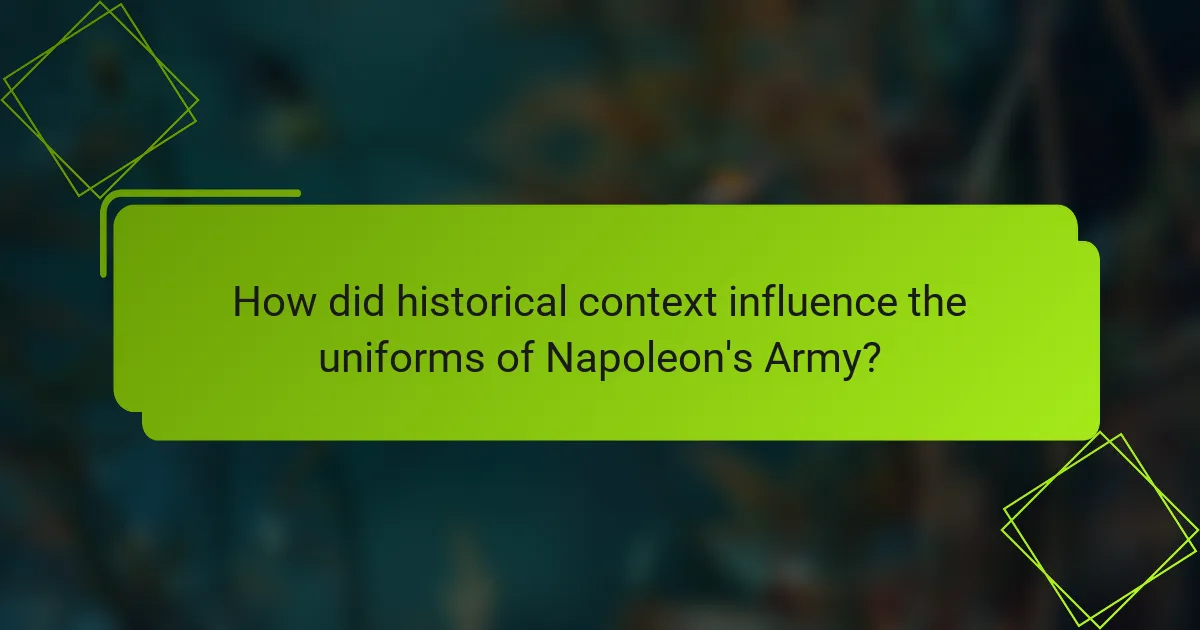
How did historical context influence the uniforms of Napoleon’s Army?
The historical context significantly influenced the uniforms of Napoleon’s Army. The French Revolution established a desire for egalitarianism, which led to the adoption of simpler designs. Soldiers wore uniforms that symbolized national pride and unity. The need for quick identification on the battlefield also shaped uniform colors and styles. Bright colors like blue and red were chosen for visibility. Military reforms under Napoleon emphasized discipline and order, reflected in uniform standards. The influence of earlier military styles, such as those from the Ancien Régime, also persisted in design elements. Ultimately, the uniforms conveyed both military function and revolutionary ideals.
What historical events shaped the design of these uniforms?
The design of Napoleon’s army uniforms was shaped by several historical events. The French Revolution in 1789 led to a need for a new military identity. This period emphasized equality and meritocracy, influencing uniform styles to reflect these values. The Napoleonic Wars (1803-1815) further necessitated distinctive uniforms for recognition on the battlefield. The introduction of the shako in 1800 standardized headgear across the army. Additionally, the influence of previous military traditions, such as those from the Ancien Régime, shaped elements like color and insignia. The need for practicality in various climates also guided fabric choices and designs. These events collectively forged a unique military aesthetic that symbolized both power and national pride.
How did the Napoleonic Wars impact uniform styles?
The Napoleonic Wars significantly influenced military uniform styles across Europe. The introduction of the French army’s distinctive styles set new standards for military attire. Bright colors and elaborate designs became prevalent during this period. The use of epaulettes and bicorne hats was popularized by Napoleon’s troops. These elements were adopted by various armies seeking to emulate French military success. The wars also emphasized practicality and functionality in uniform design. As a result, uniforms began to incorporate features for better mobility and comfort. The legacy of these changes can still be seen in modern military uniforms today.
What cultural influences were evident in the uniform designs?
Cultural influences in the uniform designs of Napoleon’s army included elements from various European nations. French military traditions prominently shaped the style and structure of the uniforms. Additionally, influences from the Austro-Hungarian and Prussian military aesthetics were evident in the cut and ornamentation. The use of vibrant colors reflected both national pride and the military fashion trends of the time. Historical events, such as the French Revolution, also impacted design choices, emphasizing a shift towards more democratic and egalitarian styles. The incorporation of specific symbols and insignia represented loyalty and heritage, further showcasing cultural significance in the uniforms. The blend of these influences created a distinctive visual identity for Napoleon’s army, recognized across Europe.
How did the uniforms evolve over the course of Napoleon’s campaigns?
The uniforms of Napoleon’s army evolved significantly throughout his campaigns. Initially, they featured a simple design with blue coats and white trousers. As the campaigns progressed, the uniforms became more elaborate and standardized. The introduction of epaulettes and distinct insignia marked a shift towards greater military hierarchy. Fabrics also changed, with cotton and wool blends becoming more common for practicality. By the later stages of the campaigns, the colors became more diverse, reflecting different regiments and units. The use of bicorne hats became popular, replacing earlier headgear. This evolution reflected both the needs of the army and the influence of contemporary fashion trends. Overall, the uniforms transitioned from basic to more structured and visually distinctive attire.
What changes were made to the uniforms in response to battlefield conditions?
Uniforms were modified to enhance functionality and practicality in battlefield conditions. Key changes included the introduction of lighter fabrics for better mobility. Additionally, colors were adjusted for camouflage purposes, allowing soldiers to blend into their surroundings. The design was simplified to reduce bulk and improve comfort. Epaulettes and decorative elements were minimized to prevent snagging on equipment. These adaptations aimed to increase soldiers’ effectiveness and survival rates during combat. Historical records indicate that these changes were implemented as early as the Napoleonic Wars, reflecting the need for adaptation to evolving warfare.
How did the introduction of new technologies influence fabric and design?
The introduction of new technologies significantly influenced fabric and design in the context of Napoleon’s Army uniforms. Innovations such as the Jacquard loom allowed for intricate patterns and designs to be woven directly into fabrics. This technology increased the efficiency of fabric production, enabling faster creation of complex designs. Additionally, advancements in dyeing techniques improved color vibrancy and durability. Synthetic dyes emerged in the 19th century, allowing for a wider range of colors. Furthermore, the development of lightweight and durable materials enhanced the functionality of uniforms. These technological shifts contributed to the distinctive appearance and practicality of the uniforms worn by Napoleon’s soldiers.
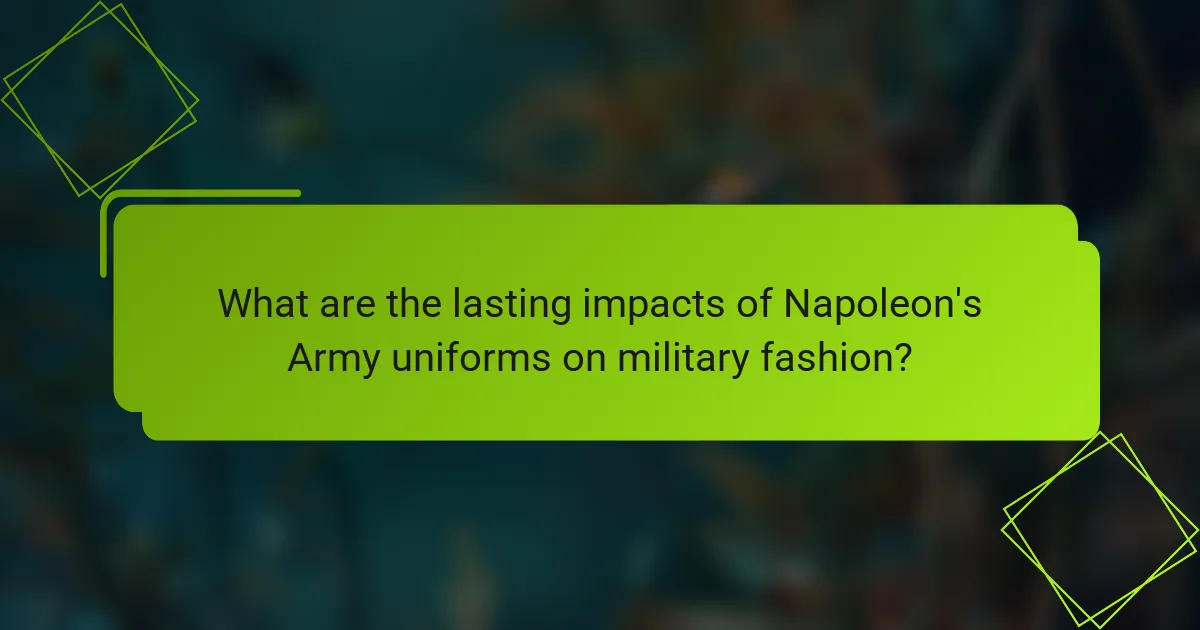
What are the lasting impacts of Napoleon’s Army uniforms on military fashion?
Napoleon’s Army uniforms significantly influenced military fashion. They introduced structured designs and bold colors that became standards in military attire. The iconic bicorne hat became a symbol of authority and is still referenced in modern military headgear. Tailored fits emphasized discipline and professionalism, setting a precedent for contemporary uniforms. The use of epaulettes and insignia for rank differentiation originated from these uniforms. Additionally, the emphasis on ceremonial dress influenced modern military parades and formal occasions. Overall, Napoleon’s uniform designs established a lasting legacy in military fashion that persists today.
How have Napoleon’s uniforms influenced modern military attire?
Napoleon’s uniforms have significantly influenced modern military attire through their design elements and color schemes. The use of tailored fits and structured silhouettes in his uniforms set a precedent for contemporary military clothing. The incorporation of bright colors, such as the iconic blue and red, has been adopted in various military forces worldwide. Additionally, the epaulettes and brass buttons seen in Napoleon’s attire have become standard features in modern uniforms. The emphasis on functionality and ease of movement in his designs has also been reflected in current military gear. Overall, Napoleon’s influence is evident in the aesthetic and practical aspects of today’s military uniforms.
What elements of these uniforms can still be seen in contemporary military uniforms?
Elements of Napoleon’s army uniforms that can still be seen in contemporary military uniforms include the use of epaulets, specific color schemes, and structured designs. Epaulets were used to signify rank and are still present in many military uniforms today. The color schemes, often featuring bold colors like blue, red, and white, influence modern military attire. Structured designs that emphasize formality and discipline remain a hallmark of military uniforms. Additionally, the use of insignia and badges for identification has roots in the historical uniforms of Napoleon’s army. These elements reflect a continuity in military tradition and identity.
How do historians view the significance of these uniforms today?
Historians view the significance of Napoleon’s army uniforms as a reflection of military innovation and national identity. These uniforms represented the ideals of the French Revolution, emphasizing equality and unity. The design elements, such as bright colors and distinct styles, were intended to enhance visibility and morale on the battlefield. Additionally, the uniforms showcased advancements in textile technology of the time, influencing future military attire. Many historians argue that these uniforms played a crucial role in the psychological aspects of warfare. They helped to create a sense of pride and cohesion among troops. Overall, the significance of these uniforms lies in their embodiment of historical, cultural, and technological transformations during the Napoleonic era.
What practical tips can be drawn from the study of Napoleon’s Army uniforms?
Practical tips from studying Napoleon’s Army uniforms include prioritizing functionality and durability in design. The uniforms were made from high-quality fabrics that withstood harsh conditions. Selecting colors that provided both visibility and camouflage was essential. Tailoring for comfort and mobility enhanced soldier performance. Incorporating distinctive insignia fostered unit identity and morale. Understanding historical context can inform modern uniform design. Analyzing the layering of materials can improve thermal regulation. Lastly, studying the evolution of these uniforms can guide contemporary fashion and military attire.
How can understanding these uniforms enhance historical reenactments?
Understanding the uniforms of Napoleon’s army enhances historical reenactments by providing authenticity. Accurate uniforms reflect the specific time period and military hierarchy. This attention to detail allows participants to portray characters more convincingly. Knowledge of colors and fabrics contributes to visual accuracy. For example, the distinctive blue coats and white trousers are emblematic of the era. Participants can also engage in discussions about the significance of uniform design. This deepens the educational value for both reenactors and audiences. Overall, understanding these uniforms fosters a richer, more immersive experience in historical reenactments.
What resources are available for those interested in military uniform design?
Resources available for those interested in military uniform design include books, online courses, and museums. Books such as “Military Uniforms in America” provide historical context and design insights. Online platforms like Coursera offer courses on fashion design that can be applied to military uniforms. Museums with military exhibits often showcase original uniforms and design elements. Additionally, academic journals on fashion history may publish research on military uniform evolution. Websites dedicated to military history also provide articles and resources on uniform design. These resources help enthusiasts and designers understand the complexities of military uniform aesthetics.
The main entity of the article is the distinctive uniforms of Napoleon’s Army, which are characterized by specific design elements, colors, and fabrics. The article provides a comprehensive overview of how these uniforms reflected military strategy, with bright colors facilitating visibility and quick identification on the battlefield. It discusses the variations in design across different ranks, the significance of color choices, and the types of fabrics used, highlighting their impact on functionality and soldier performance. Additionally, the article examines the historical context that influenced uniform design, the evolution of these uniforms throughout Napoleon’s campaigns, and their lasting effects on modern military fashion.
